There are not much to be written or told, as the dark depths of the Aegean Sea become the damp, unclaimed graves for thousands of exiled Syrian refugees, obliged to abandon their families, their homes, their lives.
The collapse of an entire country is inevitably marked by the destruction of its great civilization, as numerous reports have brought to light through these years: Isis blew up the Arch of Triumph in 2000-year-old city Palmyra in October 2015, while a month later Russia`s air force started bombing Isis targets in the same area. The Deir ez-Zor pedestrian bridge was destroyed as well by shelling in 2013. The scale of destruction is unspeakable: In 2014 the famous Norias of Hama have come under attack by drunken forces and partially demolished. A year ago, another major landmark of the region, Aleppo`s Umayyad mosque, was destroyed in 2013. The mosque, built between the 8th and 13th centuries, is reputedly home to the remains of John the Baptist`s father. It is located in Aleppo`s walled Old City, a Unesco World Heritage site. Archaeologists, left terrified after these dreadful havoc, stated that this is like blowing up the the Taj Mahal or destroying the Acropolis in Athens.
But these comparisons are meaningless when compared to the human loss and grief. What is now left by the great Syrian monuments, is ruins, memories and dust. And what there`s still left, is some brave, persistent people, trying to restore the monuments, not of course, stone by stone, but in a humanly tender, moving way: By carving and crafting the masterpieces of Syrian culture in miniatures. This is how a group of Syrian artists currently living in Jordan’s Za’atari refugee camp decided to abolish the perception of being powerless, incapable of dealing with the fear.
Αrt may not be able to stop the war. Probably, it can not even heal its wounds. But if art can offer anything, where everything else seems to have come to an end, is a faint while vitalizing promise of happiness.
Cover photo caption: Mahmoud Hariri, 25, was an art teacher and painter in Syria before seeking refuge in Za’atari in 2013. “When I first arrived I didn’t think I would continue my work as I only expected to be here for a week or two. But when I realised it would be years, I knew I had to start again or lose my skills.” “I’m very worried about what is happening. This site represents our history and culture, not just for Syrians but all of humanity. If it is destroyed it can never be rebuilt.”
Mahmoud built a model of Palmyra using clay and wooden kebab skewers. While working on it, he learned that the site had fallen under the control of armed groups.
Photography: UNHCR / Christopher Herwig
All captions by UNHCR
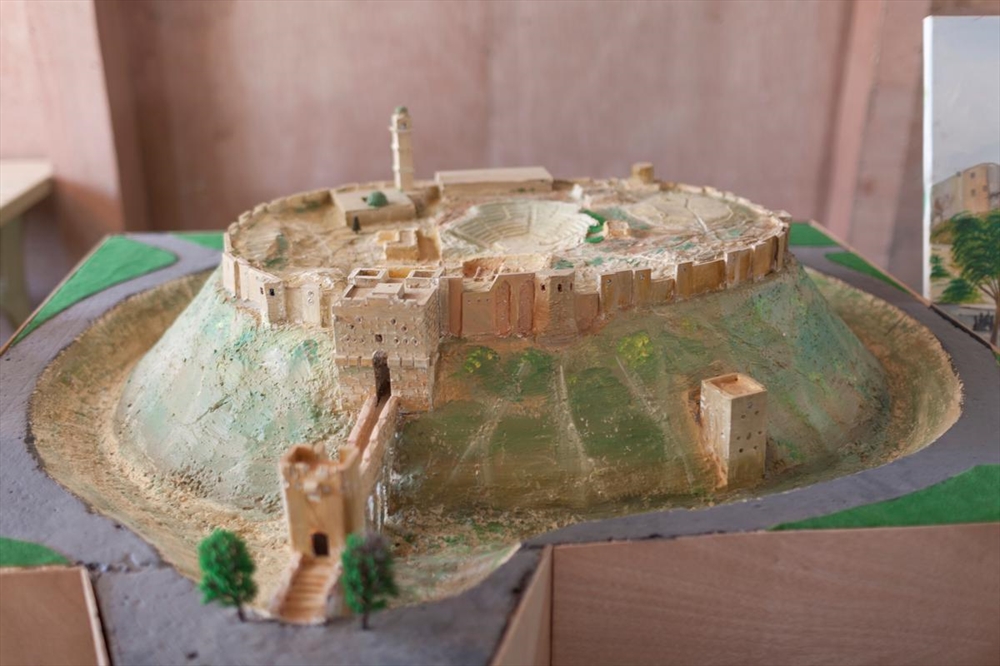 THE CITADEL OF ALEPPO IS ONE OF THE MINIATURE REPLICAS CREATED BY THE ARTISTS. THE MEDIEVAL STRUCTURE IS ONE OF THE OLDEST AND LARGEST CASTLES IN THE WORLD, AND IT TOWERS OVER THE OLD CITY FROM A STRATEGIC POSITION ATOP A 40-METRE-HIGH PLATEAU. WHILE CONSTRUCTION OF THE CURRENT FORTRESS DATES FROM THE 12TH AND 13TH CENTURIES A.D., THE SITE ITSELF CONTAINS EVIDENCE OF OCCUPATION BY CIVILIZATIONS DATING BACK MILLENNIA. DECLARED A UNESCO WORLD HERITAGE SITE IN 1986.
THE CITADEL OF ALEPPO IS ONE OF THE MINIATURE REPLICAS CREATED BY THE ARTISTS. THE MEDIEVAL STRUCTURE IS ONE OF THE OLDEST AND LARGEST CASTLES IN THE WORLD, AND IT TOWERS OVER THE OLD CITY FROM A STRATEGIC POSITION ATOP A 40-METRE-HIGH PLATEAU. WHILE CONSTRUCTION OF THE CURRENT FORTRESS DATES FROM THE 12TH AND 13TH CENTURIES A.D., THE SITE ITSELF CONTAINS EVIDENCE OF OCCUPATION BY CIVILIZATIONS DATING BACK MILLENNIA. DECLARED A UNESCO WORLD HERITAGE SITE IN 1986. FAMED MILITARY AND POLITICAL LEADER AYYUBID SULTAN SALADIN ALSO FEATURES AMONG THE REPLICAS CREATED BY THE ARTISTS. A HUGE BRONZE STATUE OF THE MAN WHO SUCCESSFULLY LED MUSLIM OPPOSITION TO THE EUROPEAN CRUSADERS IN THE LEVANT DURING THE 12TH CENTURY HAS STOOD IN FRONT OF THE MEDIEVAL CITADEL OF DAMASCUS SINCE 1993. THE STATUE WAS UNVEILED TO MARK THE 800TH ANNIVERSARY OF SALADIN?S DEATH.
FAMED MILITARY AND POLITICAL LEADER AYYUBID SULTAN SALADIN ALSO FEATURES AMONG THE REPLICAS CREATED BY THE ARTISTS. A HUGE BRONZE STATUE OF THE MAN WHO SUCCESSFULLY LED MUSLIM OPPOSITION TO THE EUROPEAN CRUSADERS IN THE LEVANT DURING THE 12TH CENTURY HAS STOOD IN FRONT OF THE MEDIEVAL CITADEL OF DAMASCUS SINCE 1993. THE STATUE WAS UNVEILED TO MARK THE 800TH ANNIVERSARY OF SALADIN?S DEATH.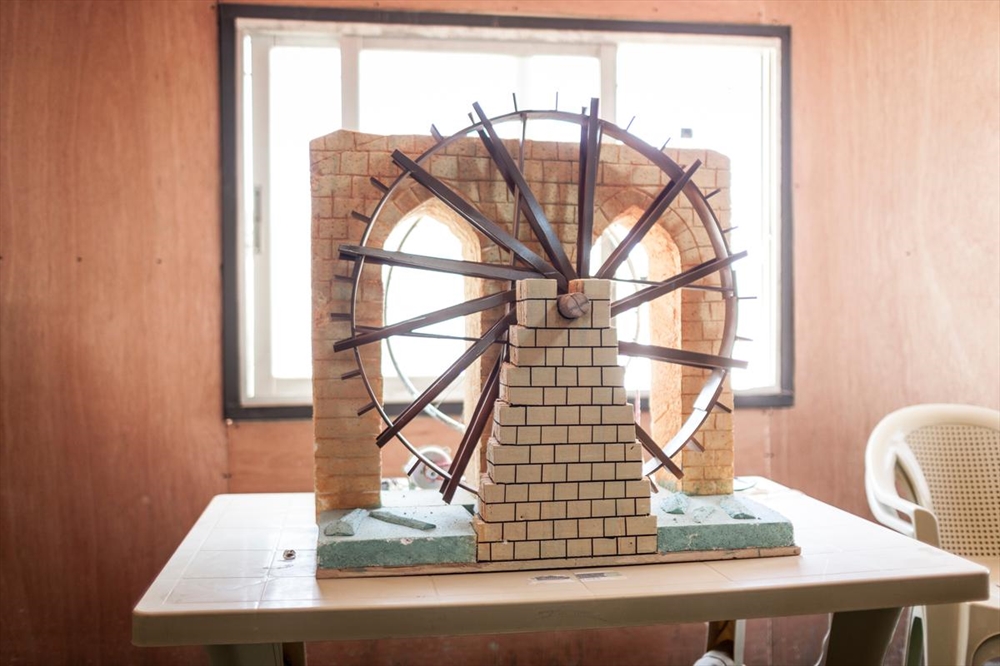 THE NORIAS OF HAMA, CONSTRUCTED OVER 750 YEARS AGO ALONG THE ORONTES RIVER, USED THE POWER OF THE CURRENT TO LIFT POTS OF WATER TO HIGHER ELEVATION. THIS MINIATURE REPLICA WAS DISPLAYED AT THE COMMUNITY CENTRE IN ZA?ATARI.
THE NORIAS OF HAMA, CONSTRUCTED OVER 750 YEARS AGO ALONG THE ORONTES RIVER, USED THE POWER OF THE CURRENT TO LIFT POTS OF WATER TO HIGHER ELEVATION. THIS MINIATURE REPLICA WAS DISPLAYED AT THE COMMUNITY CENTRE IN ZA?ATARI.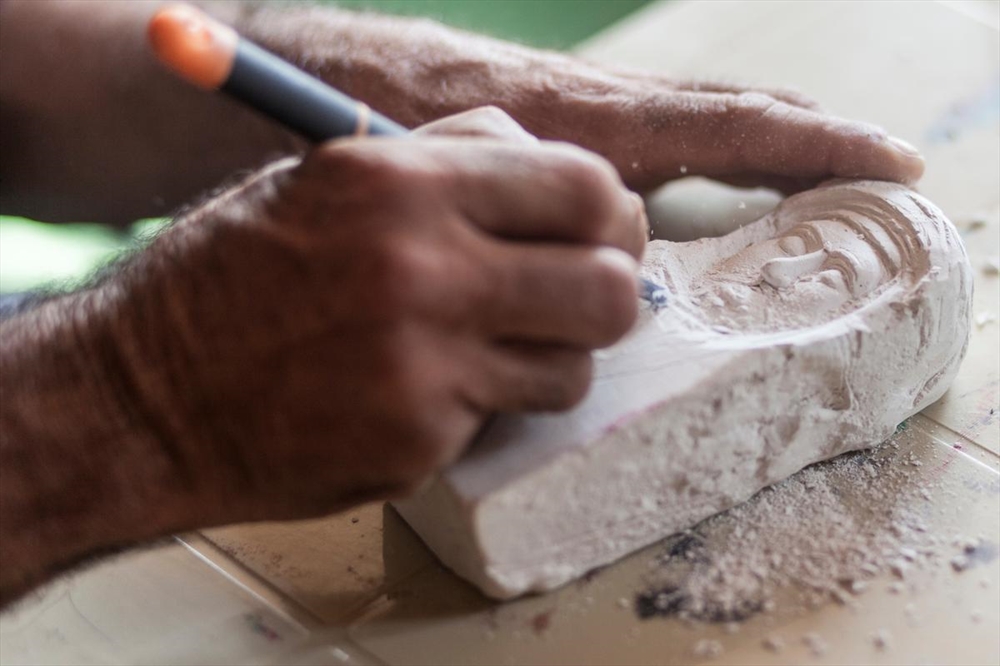 ISMAIL MADE SEVERAL SCULPTURES FOR THE EXHIBITION. HIS FAVOURITE DEPICTS THE NABATEAN GATE AND ARCH AT BOSRA, NEAR DARA?A. LIKE THE ORIGINAL, IT IS MADE FROM VOLCANIC STONE, WHICH HE FOUND IN THE CAMP.
ISMAIL MADE SEVERAL SCULPTURES FOR THE EXHIBITION. HIS FAVOURITE DEPICTS THE NABATEAN GATE AND ARCH AT BOSRA, NEAR DARA?A. LIKE THE ORIGINAL, IT IS MADE FROM VOLCANIC STONE, WHICH HE FOUND IN THE CAMP.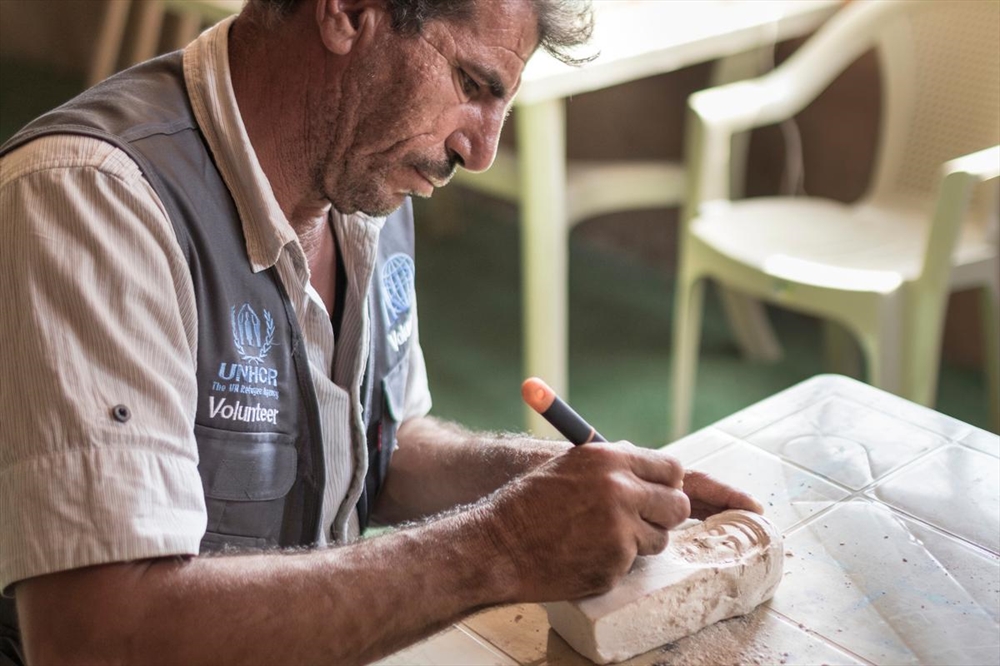 ISMAIL HARIRI, 44, BEGAN SCULPTING AT AN EARLY AGE. HE WORKED AS AN INTERIOR DESIGNER BEFORE THE CONFLICT FORCED HIM TO FLEE TO JORDAN WITH HIS WIFE AND CHILDREN IN 2013. AFTER ARRIVING IN ZA?ATARI, HE WAS RELUCTANT TO TAKE UP SCULPTING AGAIN. BUT AFTER HEARING ABOUT THE PROJECT HE REDISCOVERED HIS PASSION.
ISMAIL HARIRI, 44, BEGAN SCULPTING AT AN EARLY AGE. HE WORKED AS AN INTERIOR DESIGNER BEFORE THE CONFLICT FORCED HIM TO FLEE TO JORDAN WITH HIS WIFE AND CHILDREN IN 2013. AFTER ARRIVING IN ZA?ATARI, HE WAS RELUCTANT TO TAKE UP SCULPTING AGAIN. BUT AFTER HEARING ABOUT THE PROJECT HE REDISCOVERED HIS PASSION. 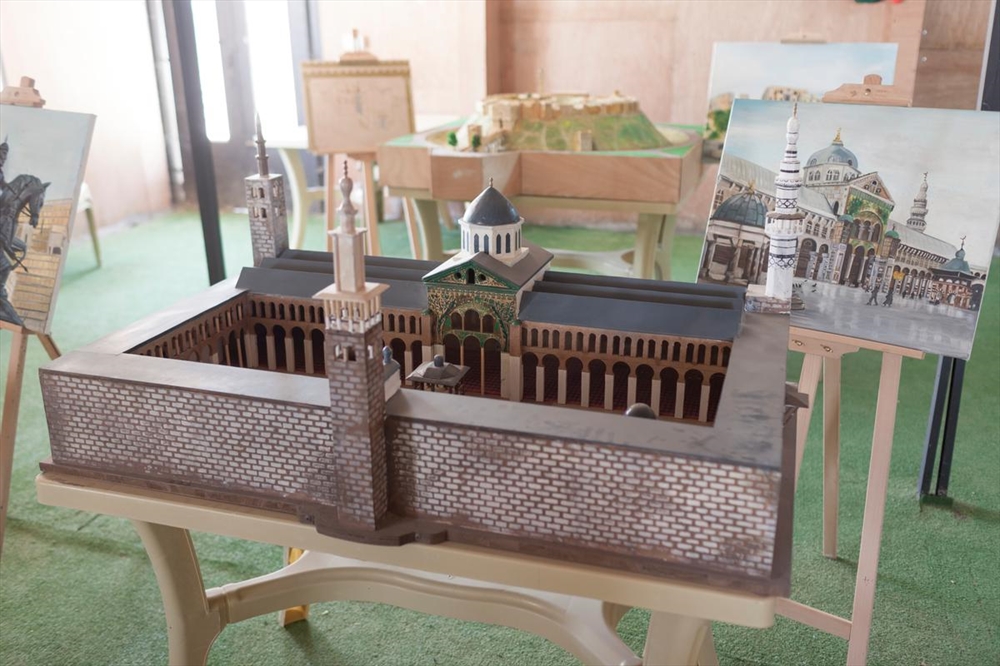 THE UMAYYAD MOSQUE IN DAMASCUS, BUILT 1,300 YEARS AGO, IS SAID TO BE ONE OF THE LARGEST AND OLDEST MOSQUES IN THE WORLD. IT INSPIRED ONE OF THE MINIATURE REPLICAS DISPLAYED AT THE COMMUNITY CENTRE IN ZA?ATARI CAMP.
THE UMAYYAD MOSQUE IN DAMASCUS, BUILT 1,300 YEARS AGO, IS SAID TO BE ONE OF THE LARGEST AND OLDEST MOSQUES IN THE WORLD. IT INSPIRED ONE OF THE MINIATURE REPLICAS DISPLAYED AT THE COMMUNITY CENTRE IN ZA?ATARI CAMP.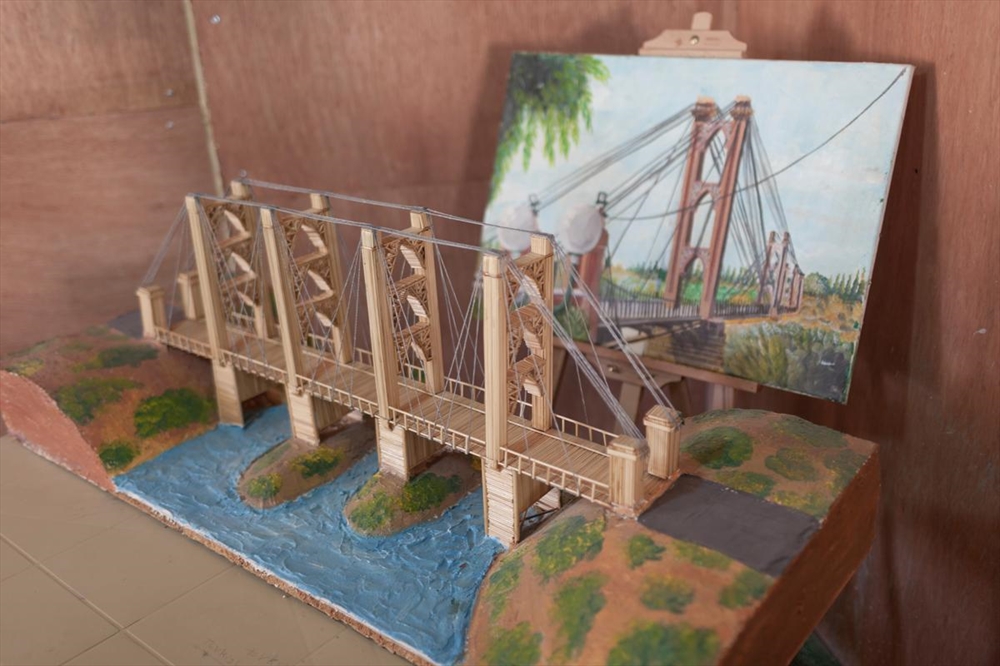 ERECTED FOR PEDESTRIANS IN 1927, THE DEIR EZ-ZOR SUSPENSION BRIDGE SPANNED THE EUPHRATES RIVER IN NORTH-EASTERN SYRIA. IT WAS DESTROYED BY SHELLING IN 2013, BUT IS REMEMBERED IN THIS MINIATURE REPLICA, WHICH WAS SHOWN AT THE COMMUNITY CENTRE IN ZA?ATARI.
ERECTED FOR PEDESTRIANS IN 1927, THE DEIR EZ-ZOR SUSPENSION BRIDGE SPANNED THE EUPHRATES RIVER IN NORTH-EASTERN SYRIA. IT WAS DESTROYED BY SHELLING IN 2013, BUT IS REMEMBERED IN THIS MINIATURE REPLICA, WHICH WAS SHOWN AT THE COMMUNITY CENTRE IN ZA?ATARI.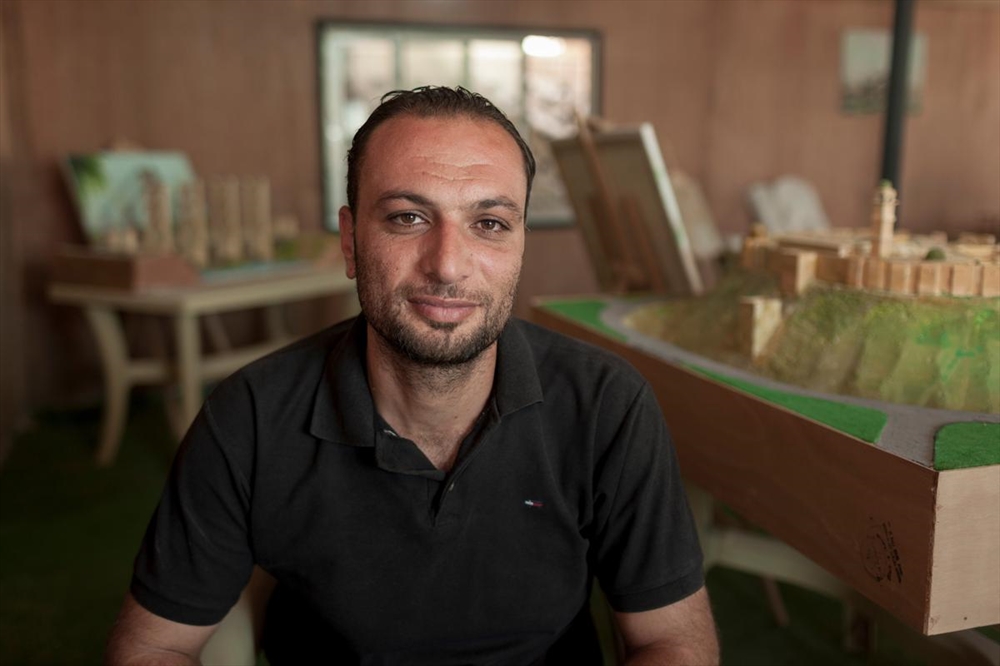 AHMAD HARIRI, WHO INITIALLY BROUGHT THE GROUP TOGETHER AND HELPS SOURCE THEIR MATERIALS, HOPES THE PROJECT WILL HELP EDUCATE CHILDREN IN THE CAMP ABOUT THEIR HOMELAND.
AHMAD HARIRI, WHO INITIALLY BROUGHT THE GROUP TOGETHER AND HELPS SOURCE THEIR MATERIALS, HOPES THE PROJECT WILL HELP EDUCATE CHILDREN IN THE CAMP ABOUT THEIR HOMELAND.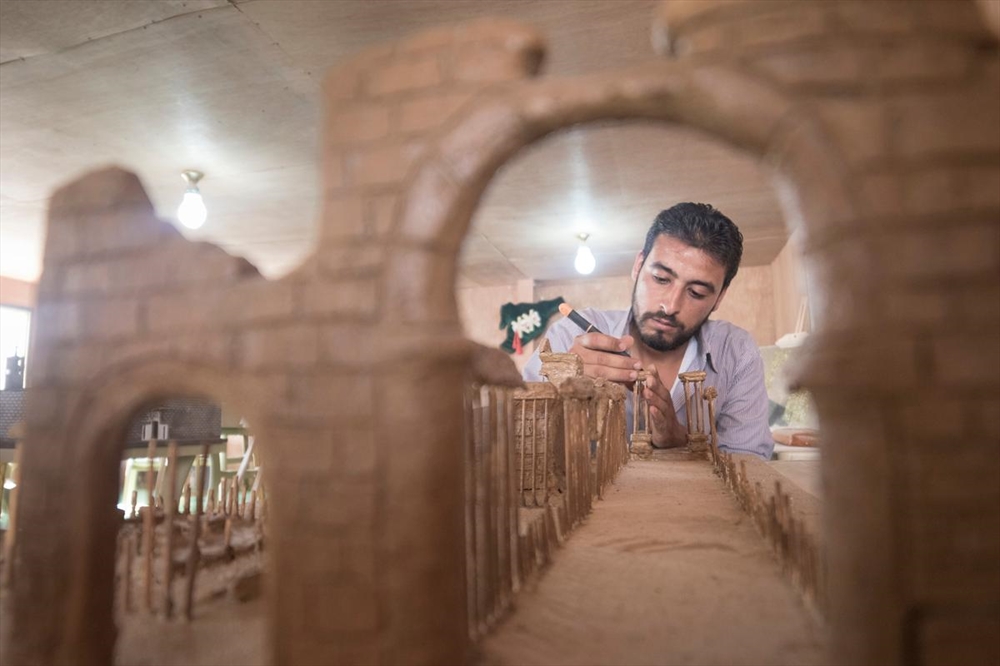 THE ARTISTS DISPLAYED THEIR ARCHITECTURAL MODELS AT A COMMUNITY CENTRE RUN JOINTLY BY UNHCR AND AN NGO PARTNER, INTERNATIONAL RELIEF AND DEVELOPMENT. THEY HAVE ALSO BEEN SHOWN AT AN EXHIBITION IN THE JORDANIAN CAPITAL, AMMAN.
THE ARTISTS DISPLAYED THEIR ARCHITECTURAL MODELS AT A COMMUNITY CENTRE RUN JOINTLY BY UNHCR AND AN NGO PARTNER, INTERNATIONAL RELIEF AND DEVELOPMENT. THEY HAVE ALSO BEEN SHOWN AT AN EXHIBITION IN THE JORDANIAN CAPITAL, AMMAN.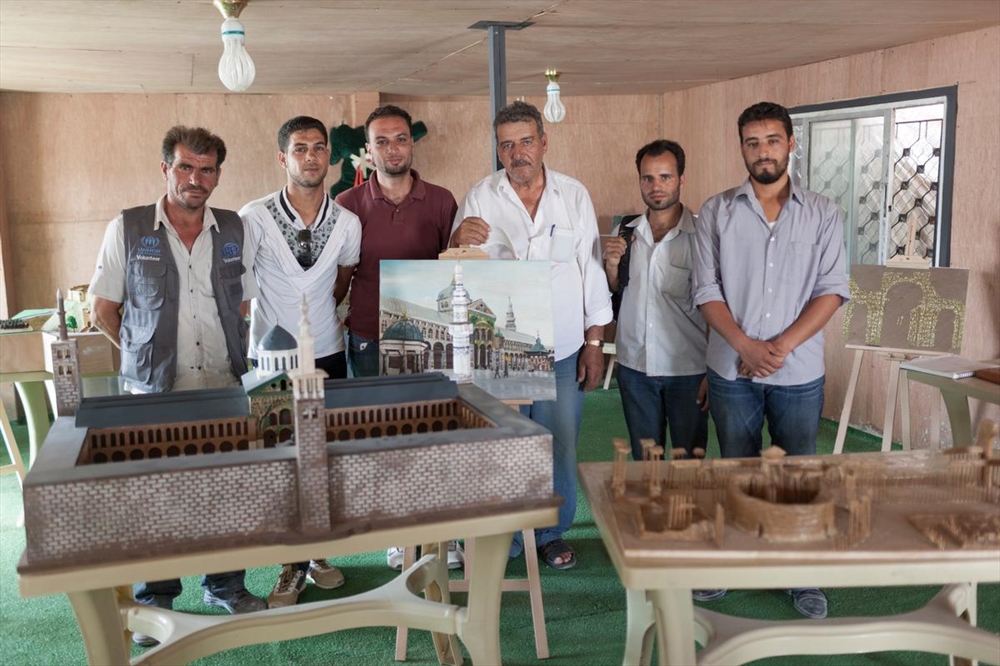 IN JORDAN?S ZA?ATARI REFUGEE CAMP A GROUP OF SYRIAN ARTISTS IS WORKING WITH BASIC TOOLS AND MATERIALS SOURCED FROM AROUND THE CAMP. THEY ARE USING LOCAL STONE, POLYSTYRENE AND DISCARDED WOOD.
IN JORDAN?S ZA?ATARI REFUGEE CAMP A GROUP OF SYRIAN ARTISTS IS WORKING WITH BASIC TOOLS AND MATERIALS SOURCED FROM AROUND THE CAMP. THEY ARE USING LOCAL STONE, POLYSTYRENE AND DISCARDED WOOD.READ ALSO: DAVIDE TRABUCCO CREATES INSPIRING MASHUPS WITH CELEBRATED WORKS OF ART